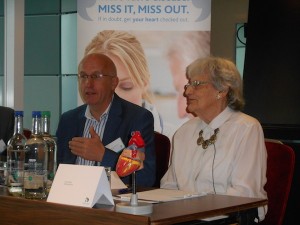GPs are failing to spot heart valve disease even though they could use a cheap and effective diagnosis method, a survey of the patients aged 60+ has revealed.
The humble staple of doctors everywhere, the low-tech stethoscope was once the mainstay of medical diagnosis but is now largely ignored as a “the one key action that could potentially detect heart valve disease”, putting the lives of 1million older people at risk each year, according to a new health pressure group.
More than half of those questioned in the 2014 European Heart Valve Survey, carried out on behalf of the Heart Valve Voice, a charity to promote earlier diagnosis and treatment, said their doctor rarely or never checks their heart with a stethoscope.
The survey also revealed that people over the age of 60 in the UK are less likely to have their heart checked with a stethoscope than those of a similar age in most other European countries. In the survey of 9,579 people aged over 65, in 10 countries, the UK came second from last in the use of the stethoscope in diagnosis of heart valve disease in the over 60s. In the UK 1,005 adults aged over 60 took part.
Key findings included:
- Nearly half of those aged over 60 in the UK did not know what aortic stenosis is
- Almost 1 in 3 feared the impact of heart disease
- Nearly in 5 would be more likely to seek medical advice on heart conditions if they were aware of less invasive options
The survey was sponsored by Edwards Lifescienes, a global manufacturer of heart valves and other life-saving devices.
Valve disease, known as “the silent killer” is caused by ageing and disease leading to narrowing of the blood flow to the heart, which if left untreated may eventually lead to heart failure. The UK’s increasing ageing population means that the number of sufferers is likely to increase.
The two most common types of the disease are, aortic stenosis when the arteries harden or calcify and mitral stenosis when there is an obstruction of the heart valve. Both can be successful treated with early surgical intervention.
One of the challenges for doctors is that the symptoms are easily confused with other illnesses and include chest pain, tiredness and breathing difficulties. Unfortunately , for many patients, these are often put down to the inevitability of ageing.
Professor Ben Brigewater, Chairman of Heart Value Voice (HVV) and Consultant Cardiac Surgeon at University Hospital South Manchester said: “Heart valve disease can have catastrophic consequences if the symptoms are mistaken or simply put down as being a sign of ageing.”
HVV said the challenges in getting early diagnosis and a better outcome for patients included GPs lack of knowledge of heart disease, the difficulty of identifying the symptoms, late diagnosis and the infrequency of using stethoscopes to listen to a patient’s heart.
“Stethoscopes are infrequently used by physicians in primary care to listen to a patient’s heart when they present with potential symptoms of heart value disease – the one key action that could potentially detect heart value disease.”
The stethoscope was invented more than 200 years ago in a French chest hospital and was used, like an ear trumpet, to listen to a patient’s heart and intestines. Since then it has undergone a number of refinements and was until recently considered a mainstay of a doctor’s vocation The favoured manufacture is Littmann, and even though sophistication and costs vary, it still only costs circa £80.
Patient Case Study
Ivy Lovell is 90-years-old, a mother, grandmother, great-grandmother and more recently a heart valve patient. Just over four years ago, Ivy become out of breath when walking and started to suffer from dizziness which resulted in a number of falls.
Following tests, she was sent to King’s College Hospital in London where she was told that her heart valve was no longer functioning properly and her heart was in such a bad way that is she didn’t have what is called a Transcatheter Aortic Valve Implantation (TAVI) procedure to repair the problems she would only have another two years to live.
Even though Ivy was older she did not hesitate in saying yes to the procedure, which is less invasive that chest heart surgery – a catheter is inserted into the artery in the groin used to implant a new valve. She was back at home a very short time afterwards and has has been able to resume an active lifestyle, go for long walks, drive around in her car and see friends. She is completely independent and feels that she can do anything and everything.


